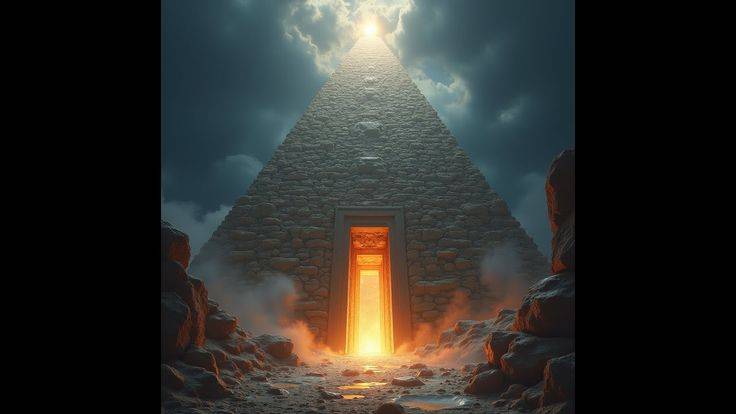For centuries, the Great Pyramid of Giza has stood as an enduring marvel, its towering presence sparking awe and curiosity. Mainstream history tells us it was built 4,500 years ago as a grand tomb for Pharaoh Khufu, a monument to honor a god-king of Egypt’s Fourth Dynasty. Yet, a closer look reveals a structure that defies the conventions of a burial site-lacking artifacts, hieroglyphs, or the ornate decorations typical of Egyptian tombs. No mummies have ever been found inside any pyramid, including this one. So, if it wasn’t a tomb, what was it? Some daring thinkers, including the visionary Nikola Tesla, suggest an astonishing possibility: the Great Pyramid was a colossal power plant, tapping into the Earth’s energy and distributing it wirelessly across the globe-an idea that might have been conceived not 4,500 years ago, but perhaps 13,500 years in the distant past.
Tesla, a genius ahead of his time, dreamed of harnessing Earth’s natural forces to deliver limitless, clean energy. His experiments with wireless power transmission in the early 20th century showed promise, lighting bulbs without wires and hinting at a world unshackled from fossil fuels. But after his death in 1943, much of his groundbreaking research vanished, leaving only whispers of what might have been. Could Tesla have stumbled upon a secret hidden in plain sight for millennia? Some theorists argue that the Great Pyramid wasn’t his invention but a rediscovery-an ancient machine engineered with precision that modern technology struggles to replicate.
Consider the pyramid’s construction. Rising 481 feet and sprawling across 13 acres, it’s a mountain of 2.5 million stone blocks, weighing a staggering 6 million tons. Its base aligns with the cardinal directions to within 1/15 of a degree of true north-a feat requiring accuracy we’d associate with lasers, not the bronze tools of 2500 BCE. The foundation is level to within three-quarters of an inch across its 755-foot sides, each block-some as heavy as 40 tons-fitted with a precision of 99.98%. Intriguingly, the pyramid doesn’t have four sides but eight, with each face slightly concave, a subtlety visible only from above or during the equinoxes, when shadows reveal perfect angles. Whoever built it possessed knowledge of geometry and engineering that seems almost otherworldly.
The pyramid’s dimensions also hint at a deeper understanding of our planet. Multiply its height by 43,200, and you get 3,938.685 miles-eerily close to Earth’s polar radius, off by just 11 miles (99.7% accurate). Take the base perimeter, apply the same multiplier, and you land at 24,734.94 miles, a near-match for the equatorial circumference (99.3% accurate). The number 43,200 isn’t random-it’s the seconds in a day during an equinox, a time the ancients revered. Skeptics call this a coincidence, pointing to Earth’s varying measurements, but the consistency is hard to dismiss.
The materials tell an even stranger story. The pyramid’s core is local limestone, abundant and practical, but its original casing stones-gleaming white limestone from Tura, 500 miles away-were something special. Polished to a mirror finish and fitted without visible seams, these blocks lacked magnesium, making them superb electrical insulators. Inside, the chambers and passages feature rose granite from Aswan, hundreds of miles south, rich in quartz-85% in some areas. Quartz, or silicon dioxide, generates electricity when compressed, a phenomenon called piezoelectricity, powering everything from watches to GPS today. Imagine the pyramid’s granite-lined tunnels under pressure, sparking currents like a natural generator. Was this deliberate?
Engineer Christopher Dunn has spent decades exploring this idea, proposing the pyramid as a power plant since the 1970s. His theory begins underground, where aquifers beneath the structure create sound waves as water flows. These vibrations, resonating with Earth’s natural frequency, travel upward. In the Queen’s Chamber, Dunn suggests a chemical reaction occurred-traces of hydrochloric acid in one shaft and hydrated zinc chloride in another point to hydrogen production. Mix these, and you get a volatile burst of gas, which could flow into the Grand Gallery. There, granite walls and resonators amplify the energy, compressing quartz to produce electricity and ionizing the air for conductivity.
The King’s Chamber, lined with granite beams tuned to an F-sharp chord at 440 Hertz-a frequency some claim harmonizes with Earth-acts as a Helmholtz resonator, like blowing across a bottle to make sound. Above it, five layers of rough-cut granite beams, misnamed “relieving chambers,†might have been chiseled to fine-tune this resonance. In 2018, scientists confirmed the pyramid concentrates electromagnetic energy in its chambers and base when hit with radio waves between 200 and 600 meters, lending credence to Dunn’s vision of an ancient energy machine.
But how did this energy escape? Tesla’s Wardenclyffe Tower offers a clue. Built over an aquifer with copper and iron rods plunged into the ground, it aimed to transmit power through the atmosphere. The pyramid, also atop an aquifer, has similar metal traces and, if capped with gold, could have beamed energy skyward. Both systems, theorists argue, tapped Earth’s resonance for free, clean power-a dream Tesla chased until financier J.P. Morgan pulled funding, fearing it would dismantle his empire of coal, copper, and steel. Wardenclyffe was razed in 1917; Tesla died penniless. Did the pyramid meet a similar fate?
Evidence of destruction lingers. Scorch marks in the Grand Gallery, cracks in the King’s Chamber beams, and salt deposits in a shaft suggest an explosion-perhaps from an uncontrolled hydrogen reaction triggered by a cataclysm. Some point to 9700 BCE, when the Ice Age ended abruptly. Geologist Robert Schoch argues the Sphinx’s water erosion dates to this era, when melting glaciers flooded the Giza plateau. A solar storm, not an asteroid, might have unleashed plasma and lightning, frying the pyramid’s system and leaving it dormant when Egyptians arrived millennia later, repurposing it as a ceremonial site.
Mainstream scholars insist Khufu’s people built the pyramid as a tomb, dismissing power plant theories as fringe. Yet the absence of tomb-like features and the structure’s uncanny precision fuel debate. Was it an Egyptian creation, or did they inherit it from a lost civilization-perhaps one that vanished 13,500 years ago, when Orion aligned with Giza’s layout? If true, this ancient technology could have lit the world without harming it, a harmony Tesla sought to revive. Why hasn’t it been tested today? Perhaps, like Tesla’s dream, it threatens empires built on oil and war-profits too vast to surrender.
The Great Pyramid remains an enigma, a silent giant whispering secrets of a forgotten age. As science peels back its layers, we may yet uncover a truth that redefines our past-and our future.


